Aim Trainers Comparison: Best Tools to Improve Your Aim
Updated On: October 26, 2025 by Aaron Connolly
Aim Trainers Comparison Overview
Top aim trainers each have their own quirks—some focus on a clean interface, others on scenario variety, and a few go all-in on analytics. Let’s see how Kovaak’s stripped-back style stacks up against Aim Lab’s deep-dive stats, and peek at what’s trending in the market right now.
Key Differences Between Top Aim Trainers
Interface and User Experience
Kovaak’s keeps things simple. You can hop straight into training without distractions.
Aim Lab, on the other hand, gives you detailed stats but clutters things up with extra screens between drills.
Loading times feel pretty different too. Kovaak’s moves you between exercises quickly, while Aim Lab sometimes drags its feet and breaks up your rhythm.
Scenario Variety and Customisation
Kovaak’s lets you pick from over 25,000 user-made scenarios. You can tweak almost everything to fit your training style.
Aim Lab gears its routines toward specific games like Valorant and Counter-Strike. It doesn’t have nearly as many scenarios as Kovaak’s, though.
Game Integration
| Feature | Kovaak’s | Aim Lab |
|---|---|---|
| Valorant benchmarks | Limited | Comprehensive |
| Custom scenarios | 25,000+ | Moderate |
| Physics simulation | Advanced | Standard |
| Free version | No | Yes |
Criteria for Evaluating Aim Training Tools
We look for aim trainers that track your reaction time, accuracy, and consistency. The best ones let you see your progress on easy-to-read graphs.
Your trainer should measure flick speed, tracking, and how fast you can switch targets. These skills really matter in FPS games.
Skill Level Accommodation
Beginners do best with guided routines and clear progress markers. Advanced players need tougher scenarios that push multiple skills at once.
The best trainers adjust the difficulty as you improve. That way, new players don’t get frustrated, and veterans don’t get bored.
Cost and Accessibility
Free options like Aim Lab are great for casual practice. Paid trainers like Kovaak’s pack in more advanced features and get frequent updates.
Think about your budget and how serious you are. Free trainers are a low-risk way to see if aim training actually helps you before dropping cash.
Market Trends in Aim Trainers
Community Preferences Shifting
More players now recommend Kovaak’s for focused training. Lots of folks start with Aim Lab for Valorant, then switch to Kovaak’s for deeper practice.
Gamers care about customisation and hate interruptions. Simple interfaces are winning out over bloated feature sets.
Specialisation vs Generalisation
Some new aim trainers only work with one game, like Valorant or Apex Legends. That’s becoming more common.
Still, plenty of players stick with trainers that work for any FPS. If you jump between games, general-purpose tools are still popular.
Technology Integration
Modern trainers use AI to create custom routines. Some even break down your gameplay videos to spot where you’re slipping.
Cloud saves let you train on different devices and keep all your stats in one place. That’s handy if you play on more than one setup.
Popular Aim Trainers in 2025
Four main aim trainers really stand out in 2025. Aimlabs leads with its free access and easy learning curve, while Kovaak’s brings advanced customisation for hardcore players.
Aimlabs Features and Benefits
Aimlabs tops the charts with more than 20 million users. It’s totally free on Steam, which makes it a solid pick for anyone just starting out.
You get simple warm-up drills and basic practice modes. New players can dive right into gridshot or sphere tracking—no need to mess around with settings.
The interface guides you through each exercise. You always know what to do next.
Key Features:
- Free forever, no sneaky fees
- Built-in performance stats
- Quick matchmaking for competitive drills
- Mobile app for training on the go
We really like the instant feedback. You see your accuracy and reaction time right after every session. It’s clear and helpful, especially if you’re new.
Advanced players might get bored with the limited scenarios. The default playlists are fine for casual practice, but they don’t go deep enough for real skill building.
Kovaak’s Customisation and Scenarios
Kovaak’s costs about £8.50, but it packs in a ton more features than the free stuff. Competitive players swear by it for targeted training.
You get thousands of user-made maps. Players have built copies of mechanics from Valorant, Apex Legends, and Counter-Strike. Practicing here feels just like playing your main game.
Advanced Options Include:
- Custom crosshair settings for any game
- Detailed stats tracking over months
- Community-made routines
- Sensitivity matching tools
The interface feels a bit pro, maybe even intimidating at first. Watching a few tutorials helps a lot. Most serious players think the learning curve is worth it.
Esports pros use Kovaak’s every day. Its long history means more polished scenarios and smoother performance than most new trainers.
Aimbeast Advanced Training Modes
Aimbeast leans on scientific training methods and sports psychology. It costs about £6 and is built for players who want a structured plan.
Aimbeast adjusts the difficulty automatically as you improve. You get custom sessions that target weak spots while keeping your strengths sharp.
Unique Training Features:
- AI-powered difficulty adjustment
- Cognitive load exercises
- Fatigue management tips
- Progress prediction tools
The scientific approach feels refreshing compared to just grinding drills. Sessions throw in reaction time tests, decision-making, and multitasking—so it’s closer to real in-game pressure.
The smaller community means fewer shared scenarios than Kovaak’s. Still, the built-in content always feels polished.
3D Aim Trainer Practice Tools
3D Aim Trainer runs right in your browser. No downloads, no installs, just click and play. That’s great if you’re using someone else’s computer or a mobile device.
You get basic tracking and clicking drills with decent visuals. It works fine even on old laptops that can’t handle Steam.
Browser-Based Benefits:
- Works on anything with a browser
- No storage needed
- Instant access, no accounts
- Touchscreen support
Casual players love the simplicity. It’s perfect for a quick warm-up if you’re short on time or away from your main setup.
But if you want deep stats or custom drills, you’ll hit limits fast. It just doesn’t have the features for serious long-term training.
Free Versus Paid Aim Trainers
Free aim trainers cover the basics and get you started, but paid ones unlock advanced features and a ton of scenarios. Which one fits you? That depends on how serious you are and what you need.
Best Free Aim Trainers
Aim Lab is the most popular freebie. It gives you 12 scenarios for tracking, flicking, and switching targets.
The interface is clean and easy to use. You’ll run through the same drills a lot, though.
CS’s Aim_Botz is a classic for tactical shooters. You can practice recoil control along with your aim.
It’s especially handy if you play games like VALORANT or Rainbow Six Siege. The catch? You need the full CS install.
Aimtastic offers a bit more variety than Aim Lab. It gets frequent updates and lets you match your in-game sensitivity.
It barely needs any specs to run—just 512MB RAM and a basic processor. Perfect for budget rigs.
3D Aim Trainer runs in your browser and gives you 120 levels across 11 play modes.
The 3D visuals feel more immersive than most. No download needed, so it’s easy for quick sessions.
Premium Aim Trainers: What Do You Get?
Kovaak’s 2.0 leads the paid pack with endless customisation. You can copy your exact game settings, even engine-specific stuff for CS or VALORANT.
The community keeps adding new scenarios, so you never get bored.
Sandbox mode means you can build any training routine you want. Pro players use Kovaak’s for their daily grind.
Aimbeast focuses on realistic AI movement, not just predictable bots. That makes the drills feel more like real matches.
Its map editor lets you craft custom training situations for whatever you’re struggling with.
Aim Hero keeps things simple. It asks what game you’re training for and adjusts scenarios to fit.
It supports CS, Overwatch, PUBG, and Fortnite. The lightweight design runs well on older PCs.
Which Option Offers More Value?
If you’re new, grab Aim Lab. It’s free and helps you build a practice habit without spending a penny.
Most players see big gains from basic drills before they need more advanced stuff.
Once you’re training regularly—maybe after two or three months—think about upgrading to Kovaak’s. You’ll want the extra scenarios and custom tools.
Gaming expert James Connolly puts it well: “Free trainers are great for building basics, but serious players eventually need the customisation paid options give.”
Budget breakdown:
- Free trainers: £0, always
- Kovaak’s 2.0: £8.50 on Steam
- Aimbeast: £6.99 on Steam
- Aim Hero: £4.29 on Steam
The price difference is tiny compared to most gaming gear. If you’re already buying games and peripherals, a good aim trainer is a smart add-on.
Quick tip: Download Aim Lab now and try a 10-minute session. You’ll see where you stand, no strings attached.
Platform Compatibility and Access

Aim trainers run on a bunch of platforms, from Steam to web browsers. Most pro-grade trainers need you to install them, but browser tools let you jump in instantly.
Steam and Standalone Aim Trainers
Steam has the most complete aim trainers out there. KovaaK’s costs £7.99 and gives you over 200,000 courses with deep customisation. Esports pros trust it for tracking and stats.
Aimlabs is the best free Steam pick. You get 29,000+ courses and leaderboards, plus game-specific modes.
Aimbeast runs about £6.39 and focuses on community-made content. Players can build and share custom drills with built-in editors.
Most Steam trainers sync with your favourite FPS games. You can match your sensitivity from Valorant or CS2, making training feel just like the real thing.
You’ll need Windows 10 or newer, and a decent graphics card for smooth tracking drills.
Browser-Based Aim Training Tools
Web-based trainers work on anything with a browser. 3D Aim Trainer leads here and is totally free. It runs on desktops, laptops, and even phones.
Browser tools like AimBooster skip the downloads. Just open the site and start training. That’s super handy for quick warm-ups or if you’re using a public computer.
AimTrain adds reaction time tests along with aim drills. These are good for beginners who want to try aim training without hassle.
Web trainers have some limits. You get fewer custom options and basic stats. They also need a stable internet connection to run smoothly.
Mobile support is hit-or-miss. Touch controls don’t really match mouse aiming, so phones aren’t great for serious practice.
Key Aim Training Features to Consider

When you’re picking an aim trainer, three big features really set apart the ones that actually help you get better. You want something that tracks your reaction time, offers a bunch of different scenarios to build real muscle memory, and gives you analytics that tell you what’s actually going on with your aim.
Reaction Time Measurement
Reaction time measurement tracks how fast you respond when a target pops up. Most decent aim trainers show this in milliseconds.
Average gamers usually land between 200-300ms.
Why it matters: Quick reactions win gunfights in games like Valorant and CS2. Even shaving 50ms off your reaction time over a few months can mean the difference between landing the first shot or getting eliminated.
Good aim trainers show your reaction times after every drill. Make sure you pick one that separates reaction time from accuracy—otherwise, you’re left guessing which part needs work.
What to expect: Pro esports players often hit under 180ms. If you’re starting at 300ms, don’t sweat it—steady practice usually gets most people down to 220-250ms in a few months.
Scenario Variety and Realism
Scenario variety really determines if your practice will actually help in real matches. Basic trainers just toss up static targets or simple tracking. The better ones include scenarios that mimic real gaming situations.
Essential scenario types:
- Target switching – Multiple enemies show up fast
- Tracking moving targets – Following strafing opponents
- Flick shots – Snapping quickly to new targets
- Precision aiming – Tiny hitboxes like headshots
Top aim trainers let you tweak settings so everything matches your main game. You can adjust sensitivity, field of view, and even use weapon-specific crosshairs.
Game-specific training: If you’re mostly playing one FPS, look for trainers with scenarios built for that game. Aimlab has Valorant-specific benchmarks. Kovaak’s gives you more ways to customise for any shooter.
Stat Tracking and Analytics
Detailed stats really show where you’re improving and what still needs work. Basic trackers just give you accuracy percentages. The better ones break down your performance by scenario, target size, and movement.
Key metrics to track:
- Accuracy percentage by distance
- Average time to target for different shots
- Consistency scores across sessions
- Improvement trends over weeks and months
The best trainers save your data both locally and online. You can compare sessions, spot patterns, and tweak your routine as needed.
Practical application: If your stats show 85% on static targets but only 60% on moving ones, you know exactly where to focus your next drills.
Aim Trainers for FPS Games
Modern aim trainers now have modes and settings made for specific FPS titles. VALORANT players get practice scenarios that feel just like the game, while broader FPS support means you can train for all your favorites.
Practice for VALORANT
VALORANT-specific features make some trainers stand out for Riot’s tactical shooter. KovaaK’s has community-made scenarios that copy VALORANT’s crosshair placement and those tense angle-holding moments.
VALORANT’s aiming is so precise, you really need focused training. It’s smart to start with tracking exercises at your usual sensitivity.
Most trainers let you punch in your exact VALORANT sensitivity. This way, your muscle memory carries straight into ranked matches.
Key training areas for VALORANT:
- Crosshair placement drills
- Wide peek scenarios
- Micro-corrections for headshots
- Counter-strafing accuracy
Aiming.pro has preset VALORANT setups that match your in-game settings, so you don’t have to mess with conversions.
The pros usually warm up for 15-20 minutes before diving into ranked. Consistency matters more than raw speed during these sessions.
Support for Other Popular Shooters
Cross-game compatibility is a must if you bounce between FPS games. The top trainers support sensitivity conversion for CS, Overwatch, Apex Legends, and Fortnite.
Each game needs something different. CS is all about crosshair placement and spray control. Apex Legends is tracking targets who never stop moving.
Aim Hero is great for multi-game support—it has presets for nine big FPS games, and at £3.99, it’s a bargain compared to some premium options.
Browser-based trainers like 3D Aim Trainer work on any device, no installs needed. Super handy if you’re traveling or switching setups.
Sensitivity scaling changes from game to game, so good trainers now have calculators to keep your mouse movement consistent everywhere.
Free stuff like Aiming.pro gives you solid cross-platform training with no upfront cost. If you want more stats or leaderboards, premium unlocks those extras.
Improving Your Gaming Skills with Aim Trainers
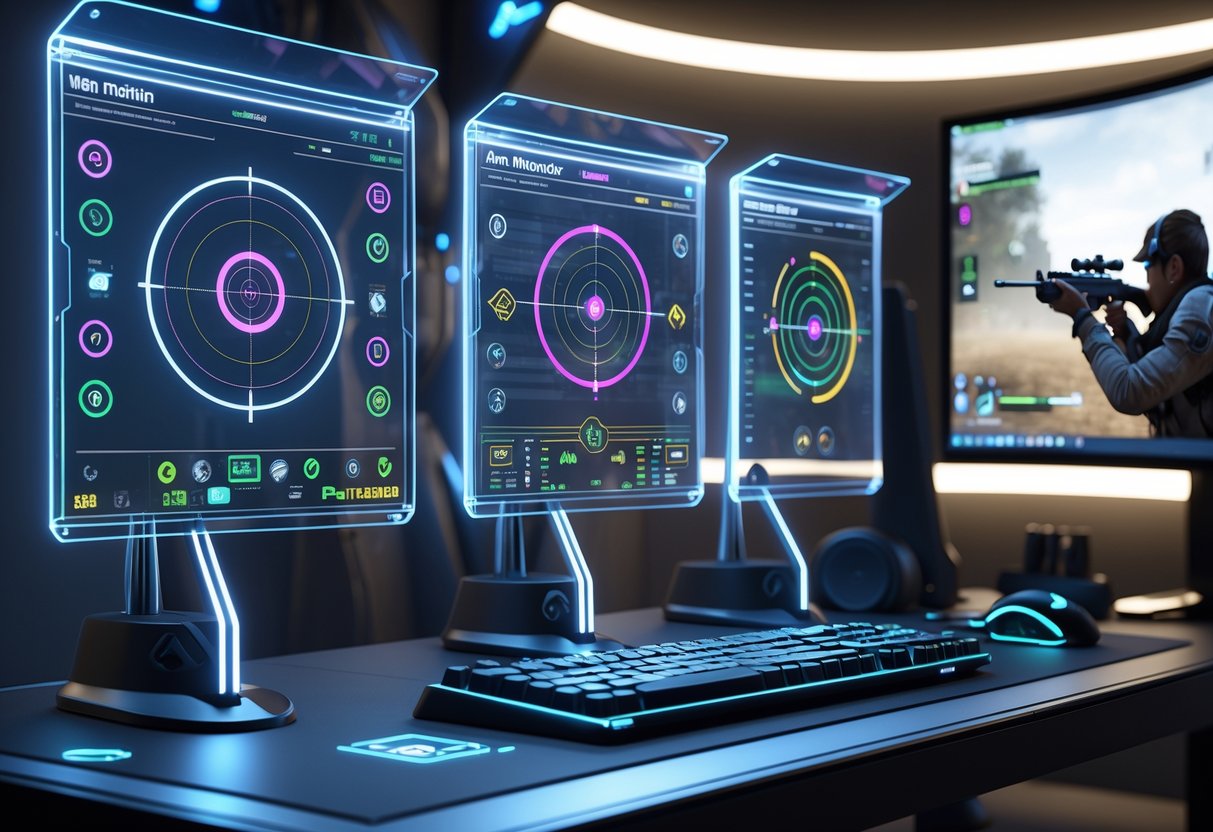
Aim trainers are basically digital shooting ranges. They help you build muscle memory and hand-eye coordination with targeted drills.
The trick is to practice specific skills—accuracy for those crisp shots, tracking for following fast-moving targets.
Achieving Accuracy and Precision
Accuracy training is all about hitting stationary targets with clean, precise clicks. This is huge in CS and VALORANT, where headshots really count.
Click-timing exercises are your bread and butter here. You’ll see static targets that you need to hit fast and on point. Start with bigger targets and shrink them as your aim sharpens.
Reaction time drills push your split-second responses. Targets pop up at random, and you have to recognize and shoot instantly. Most trainers let you tweak the timing to ramp up the challenge.
Crosshair placement practice teaches you to aim before the fight even starts. Many trainers include wall-tracking, where you keep your crosshair lined up with moving points—super useful for pre-aiming angles.
If you train for accuracy every day, you’ll usually see results in 2-3 weeks. Try 15-20 minutes of focused accuracy work before you hop into ranked.
Tracking and Flicking Exercises
Tracking drills help you follow moving targets smoothly. This skill is key in games like Overwatch and Apex Legends, where enemies are always on the move.
Smooth tracking scenarios give you targets that move in set patterns. Your job is to keep your crosshair glued to them. Start slow, then crank up the speed as you get better.
Flicking drills build your ability to snap quickly between targets. You’ll see targets appear all over the screen, and you need to hit each one with a quick wrist flick. It’s great for those high-pressure moments.
Strafe aiming mixes your own movement with tracking. You’ll practice shooting targets while you’re moving, just like in a real gunfight. It’s a tougher skill, but it really sets the top players apart.
Most trainers let you change tracking speeds and movement styles. Practice both horizontal and vertical tracking for well-rounded control.
Customisation and Community Content
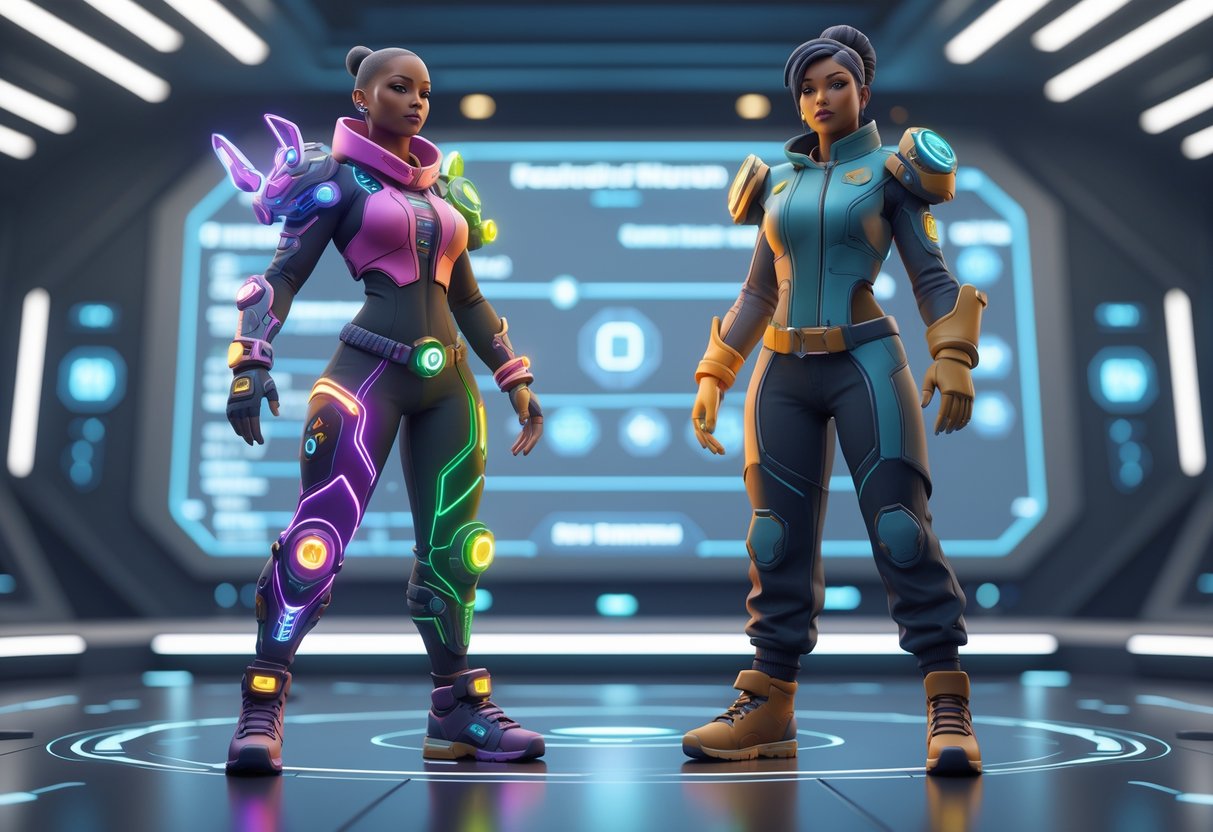
Modern aim trainers really shine with their customisation and community-driven content. You can build your own training routines or dive into thousands of scenarios other players have made.
Workshop and User-Generated Maps
KovaaK’s is king of customisation with a massive library of over 25,000 player-made scenarios. It even clones the physics from games like Valorant and CS2. You can tweak crosshairs, sensitivity, and target behavior until it feels just right.
Aimlab has a strong community workshop too. Users create custom drills for everything from flicking to tracking. You can filter scenarios by game, skill, or difficulty.
Aimbeast lets you change up visuals—custom crosshairs, hitmarkers, and map textures to match the look of your favorite game. You can even import your own maps and mess with lighting.
Most trainers let you share scenarios right in the app. Some community creators have built routines that the pros use. Honestly, a lot of user-made maps beat the official stuff for variety and quality.
Leaderboards and Progression Systems
Global leaderboards spark competitive improvement in every major aim trainer. KovaaK’s has detailed rankings and percentile scores for each scenario.
You can track your progress with stats dashboards that show how you’re doing over time.
Aimlab brings in social features like friend comparisons and team challenges. Their analytics break down accuracy, reaction time, and weak spots. Monthly challenges keep things fresh.
Progression tracking isn’t the same everywhere. Some trainers care about high scores, others focus on improvement over time. Most now have coaching playlists that get harder as you get better.
Heads up: Don’t obsess over leaderboards. Steady progress is way more important than chasing a single high score.
User Experience and Interface Quality

The look and feel of the app can really affect how much you want to use it. AimLab nails it for newcomers with a clean design, while Kovaak’s is all about function over flash.
Ease of Use for Beginners
AimLab easily wins for new users. The interface is clean and modern, with tutorials and preset routines guiding you through setup.
The dashboard puts your progress front and center. You can get started in seconds.
Kovaak’s keeps things minimal, which can be a bit much at first. The scenario library is huge but doesn’t give you much direction.
A lot of beginners feel lost in Kovaak’s menus at first. Once you get used to it, though, it’s pretty straightforward.
AimBeast lands somewhere in the middle. The setup process helps you match sensitivity and start basic drills without too much hand-holding.
| Trainer | Setup Time | Learning Curve | Beginner Friendliness |
|---|---|---|---|
| AimLab | 2-3 minutes | Very easy | Excellent |
| Kovaak’s | 5-10 minutes | Moderate | Fair |
| AimBeast | 3-5 minutes | Easy | Good |
Performance and Stability
Kovaak’s runs smooth on just about any PC. Frame rates stay solid, even with tons of targets on screen.
Loading is quick, and crashes are rare.
AimLab sometimes stutters on older systems. Some users notice frame drops during fast drills, which is pretty frustrating if you’re trying to train precision.
Since it’s free, the servers can get bogged down during busy times.
AimBeast performs well overall, but you might see slightly longer load times between drills. Once it’s running, though, it’s stable.
Unique Aim Trainers and Alternatives
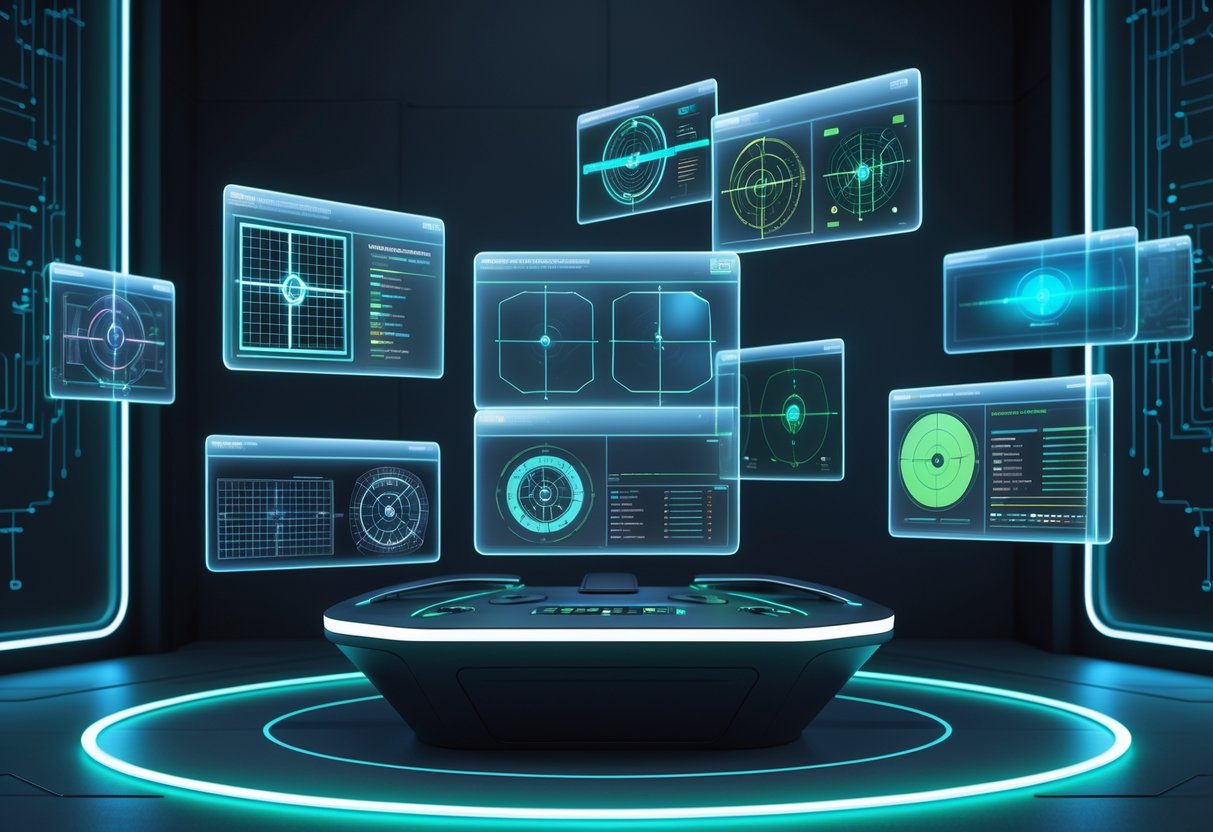
Some aim trainers take a different approach. AimBooster runs right in your browser, so you can jump in anywhere. osu! turns click training into a rhythm game, which is honestly pretty fun—even if it’s not quite the same as traditional aim training.
AimBooster and its Legacy
AimBooster made a splash in the early 2010s as one of the first free aim trainers to really catch on. You don’t need to download anything—just load it up in your browser and you’re good to go.
You get these simple clicking drills: colored targets pop up randomly, and your job is to hit them as fast as you can without missing.
Key features include:
- No installation needed
- Runs on any device with a browser
- Multiple difficulty options
- Score tracking and leaderboards
Because it’s so straightforward, AimBooster works great for quick warm-ups during work breaks. But if you want deep customization, it’s not exactly on par with modern tools like Kovaak’s or Aim Lab.
Other browser trainers like Aim Trainer.io and SteelSeries Aim Master have picked up where AimBooster left off. They’ve added features like sensitivity conversion and game-specific tweaks, but kept the easy browser setup.
osu! for Reflex and Rhythm Training
osu! turns aim training into a rhythm game. Instead of just clicking targets, you tap circles to the beat of music. It’s honestly a lot more fun than traditional target practice, and it really builds hand-eye coordination through musical timing.
You’ll notice several skills start to improve if you stick with osu!. Fast cursor movements between circles help you nail flick shots. And those rapid-fire patterns? They’ll boost your finger stamina and reaction speed.
Training benefits include:
- Sharper mouse accuracy
- Quicker reaction time
- Better hand-eye coordination
- More finger dexterity
A lot of pro FPS players swear by osu! as part of their routine. The rhythm aspect just makes grinding way less dull than endless target clicking.
osu! really shines if you play games that demand precise clicking, like Counter-Strike or VALORANT. The music keeps things interesting, so you’re less likely to get bored compared to old-school aim trainers.
Choosing the Right Aim Trainer for You
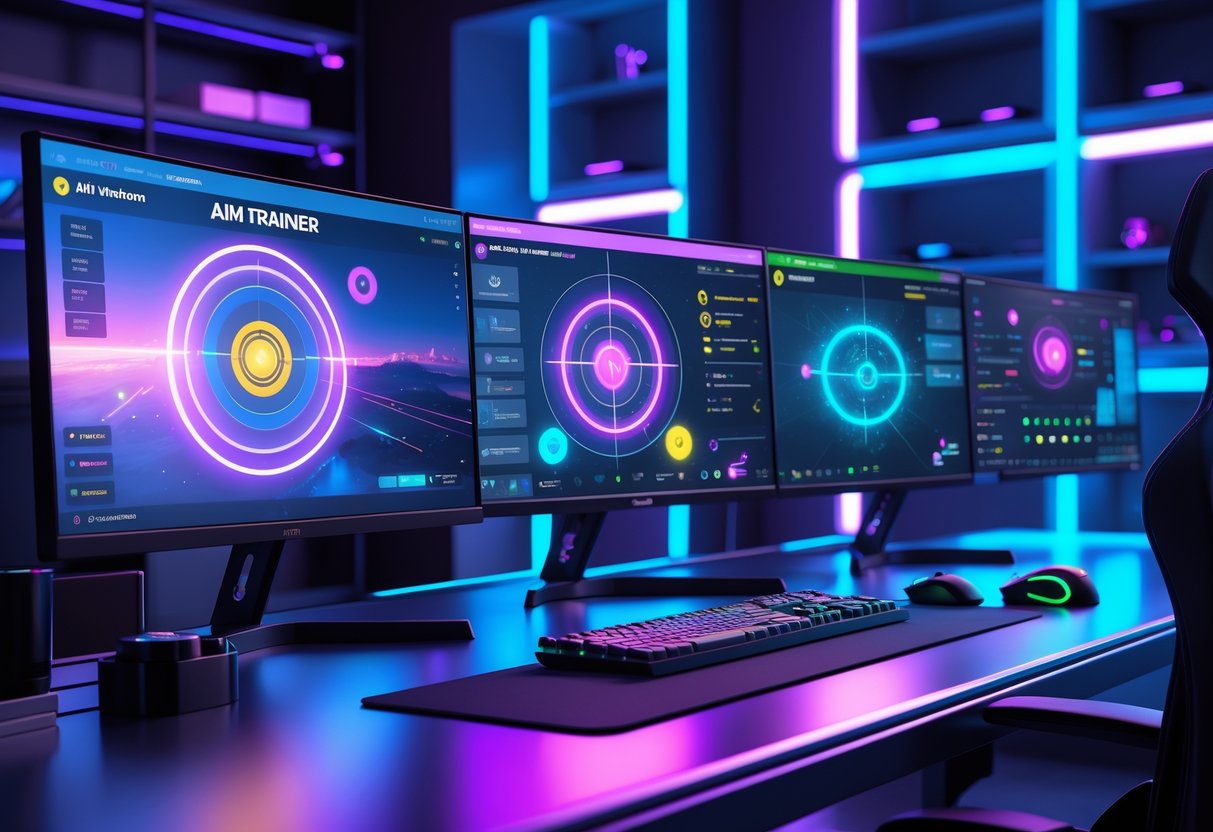
Picking the best aim trainer depends a lot on where you’re at and what you want to improve. Beginners usually do best with user-friendly platforms, but if you’re more experienced, you might want advanced features and customization.
Considerations for Different Levels
Beginners should stick with free, easy-to-use trainers that won’t feel overwhelming. Aim Lab’s got solid tutorials and simple drills that help you build up muscle memory. Plus, the interface is super clean.
Intermediate players might want a bit more variety and challenge. Kovaaks has thousands of scenarios made by the community. You’ll find drills for everything—tracking, flicking, clicking—tailored to your favorite shooters.
Advanced users should look for detailed analytics and deep customization. AimBeast delivers the smoothest performance, though it has fewer scenarios. Kovaaks is still a top pick because it mimics the physics of big games like Valorant and CS2.
Think about your hardware too. Some aim trainers need more processing power. It’s worth checking system requirements before you download anything, especially if it’s paid.
Recommendations Based on Personal Goals
If you want to improve at a specific FPS, go for trainers that match your game’s physics. Kovaaks is great here, with scenarios that feel just like Apex Legends, Overwatch, and a bunch of others. The community keeps adding targeted drills for each title.
For overall gaming skills, AimLab is a solid pick. It’s free, covers all the basics, and helps you track your progress over time.
If you’re competitive, Kovaaks or AimBeast are worth the investment. You get advanced features like:
- In-depth performance stats
- Custom sensitivity options
- Pro player routines
- Leaderboards for extra motivation
Gaming experts James Connolly and Aaron Connolly both suggest trying free trainers first. “Test different trainers to find what feels natural,” they say.
Your budget matters, too. Free trainers like 3D Aim Trainer are fine for casual improvement. Paid ones usually cost £8-15, but you get more features and regular updates.
Frequently Asked Questions
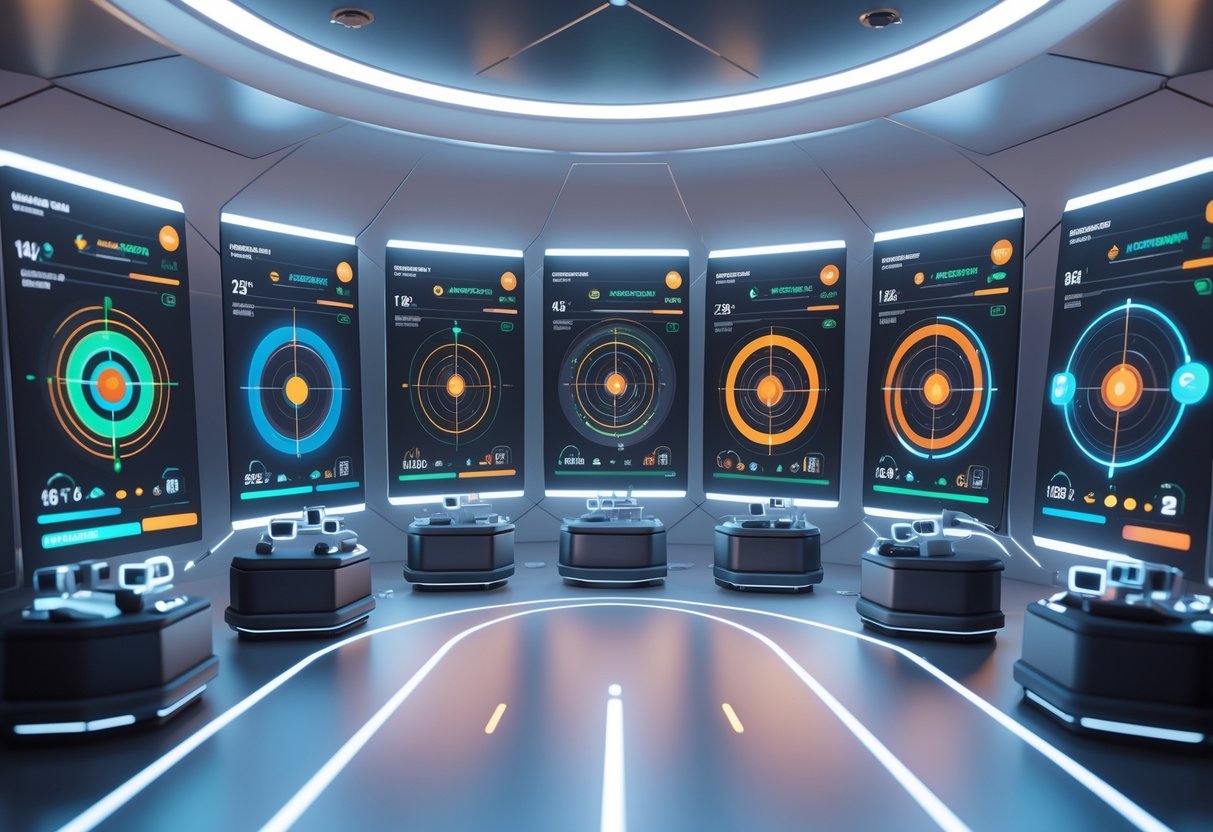
It’s easy to get lost with so many aim trainers out there. Here are some common questions people ask, plus what actually matters when you’re picking a platform.
What features should I look for in an aim trainer?
Customization tops the list. You want to match your in-game sensitivity and field of view, or your practice just won’t carry over to real matches.
Look for variety in scenarios. Good trainers let you practice flicking, tracking, and target switching. That keeps things interesting and covers all your aiming bases.
Check if the trainer supports your game’s engine. Kovaaks 2.0, for example, lets you pick Source Engine for CS or specific settings for VALORANT. That makes your training feel more like the real thing.
Community features are a plus. Trainers with active communities usually have better user-made maps and scenarios, which are often more challenging than the defaults.
How do different aim trainers help improve accuracy and speed?
Each aim trainer focuses on different skills. Tracking scenarios teach you to follow moving targets smoothly. Flicking drills help you snap to new targets fast.
Speed comes from repeating good technique. It’s better to start slow and aim well than to rush and mess up your form. Most trainers track your progress so you can see how you’re doing.
Reaction time gets better with scenarios that force quick responses. Target switching drills help you move from one enemy to another faster.
Different games demand different skills. CS is all about precise single shots, while games like Overwatch need steady tracking.
Can you recommend any free aim trainers that are effective for beginners?
Aim Lab stands out as the most popular free option, with over 20 million users. It gives you 12 different scenarios and tracks your progress. The interface is friendly for newcomers.
Aimtastic on Steam brings even more variety. You’ll find tracking, flicking, and reflex drills, plus regular updates. It’s easy to match your in-game sensitivity, too.
If you play CS, check out the Aim_Botz workshop map. It’s totally free now that CS is free-to-play. You can practice recoil control and aim at the same time—most trainers can’t do that.
3D Aim Trainer runs in your browser, no downloads needed. It offers 120 levels and 11 different modes, so it’s perfect for quick sessions anywhere.
What are the pros and cons of software versus web-based aim trainers?
Downloaded software usually gives you more customization and features. Kovaaks 2.0 and AimBeast both have thousands of community scenarios. They support precise sensitivity matching and game engine simulation.
Software trainers tend to perform better, with higher frame rates. That matters if you’re competitive and want smooth, responsive training. You can also use them offline once they’re installed.
Web-based trainers are super convenient for casual practice. You can hop on from any computer, no install required. They’re ideal for quick warm-ups or sneaky practice during breaks.
Browser trainers do have limits, though. You can’t always match your exact game settings, and performance can depend on your browser or internet speed.
How often should I practise with an aim trainer to see improvement?
Practicing daily for 15-30 minutes works better than doing long sessions just once or twice a week. Consistency is what really builds muscle memory.
Most people notice improvement after 2-4 weeks of regular practice. Of course, it depends on where you’re starting and how much you play your main games.
Warming up before gaming is especially helpful. Spending 10 minutes in an aim trainer before ranked matches can wake up your reflexes.
Don’t overdo it, though. Practicing more than an hour a day can backfire, causing tension or bad habits. Quality beats quantity every time.
What aim trainers do esports professionals commonly use?
Most pro players pick Kovaaks 2.0 as their go-to. Honestly, its crazy amount of customization and a super active community really set it apart for people who want to get serious about aim training.
A lot of pros mix in game-specific training too. If you watch CS players, you’ll notice they often run through Aim_Botz or other workshop maps, not just external trainers. That way, they get to practice aiming and also deal with those tricky recoil patterns unique to the game.
Aim Lab’s been getting more love lately, especially after streamers like TenZ started talking about it. The analytics let pros actually see how they’re improving—or not—over time, which is pretty motivating.
Pro teams usually set up structured routines that bounce between different platforms. Some days, they’ll grind Kovaaks to sharpen their raw aim, then switch to in-game maps for tactical drills.

